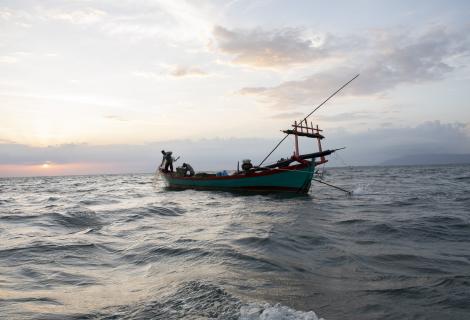
Report of Environmental and Social Impact Assessment
Impact of Development Projects On Marine Environmental Resources
Kampot is located along the coastal region of Cambodia and is among one of the largest seagrass beds in the South China Sea. Out of the 435km of Cambodian coastline, Kampot covers 66.5km of it and has a total area of 4,873km2 . Mangroves fringe the coastline, and small patches of coral reefs can be found. The seagrass bed in Kampot is among the most extensive coastal ecosystems and stretches approximately 50km along the Kampot coastline, extending through Kep and further past the Vietnamese border in Hat Yien. Some of the seagrasses extend along the coastline of Phu Quoc. Overall, the seagrass along this stretch of coastline and Phu Quoc island is growing as large patchy areas within close proximity to each other, which are all ecologically interrelated and can be considered as parts of the same seagrass ecosystem. Seagrass meadows are incredibly important coastal ecosystems. They provide spawning and nursery areas for many species, sequester large amounts of carbon and provide significant support to local livelihoods. Its importance and value to local livelihoods and its significance in terms of climate change mitigation and adoption are not properly understood and are consequently not sufficiently considered in development planning. Refed to the seagrass surveys in Kampot made by the International Union for Conservation of Nature (IUCN) during the monsoon season (May-July) 2013 founded that 11 seagrass species and covers an area of 8,435.80 hectares and is relatively healthy with a moderate to good status. Anthropogenic threats to the seagrass bed include destructive fishing practices, coastal development, sedimentation, pollution and mariculture. The most significant threat is the construction of a seaport directly on the seagrass bed, which could cause severe sedimentation throughout the whole seagrass bed, destroying large habitat areas. Without immediate long-term monitoring and conservation efforts to mitigate the threats, the seagrass bed may be under too poor conditions to adapt to the future impacts of climate change or largely wiped out before climate change impacts become noticed. Coastal livelihoods will be at risk if action is not taken soon.
Furthermore, with increased CO2 released into the atmosphere influencing global warming, it has been estimated that seagrass worldwide fixates 1% of the total carbon fixed in the ocean but store 12% (UNEP, 2004 & Mat Bjork et al, 2008). This is largely because seagrass decomposes at a slow rate. Seagrass beds are economically valued as one of the most important ecosystems in the world, approximately $3.8 trillion USD worldwide. As a whole,seagrass beds are vital to sustaining biodiversity and the economy of the region (UNEP, 2004). In Kampot and Kep province, the livelihood of Community Fisheries depends on access to and control over their land and natural resources; in particular, fisheries were threatening by the new state-led and commercial development projects. With the confirmation of OMNI Kampot Development and CHING KOR Project, both projects will cover 4,550 hectares of new fill-up land as an artificial island in Kampot (Teuk Chhou district) and Kep city of Kep province. OMNI Project will cover 3,910 hectares, which overlaps with five community fisheries (2 in Kampot and 3 in Kep provinces), while the CHING KOR project will cover 640 hectares, which overlaps with two community fisheries in Kampot Province.
Should the construction start, the new artificial island will affect more than 6,000 hectares of marine resources, most of which are the sources of livelihoods of more than 5,504 families (1,455 female), especially members of the five coastal Community Fisheries – out of 14 in Kampot and Kep provinces. There are a number of other ongoing projects. Large-scale development projects without properly and transparency of the Environmental and Social Impact Assessment will have direct negative impacts underway and rapidly destroy and degrade significant areas of this precious resource before its real value to the people in Kampot and Kep provinces and the rest of Cambodia are fully understood. Based on these concerns, and after the discussion with the Community Fisheries since February 2019, community members, as well as communes and sub-national authorities required stronger evidence to prove and support related impacts on sustainable livelihood, environmental sustainability, and tenure security, which are aligned with a matter of food security and sustainable development over land and natural resources.